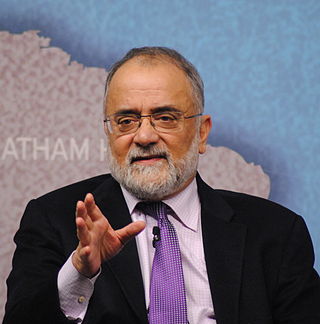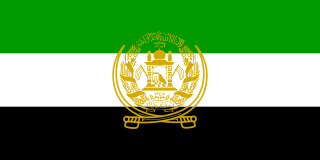
Afghanistan, officially the Islamic Emirate of Afghanistan, is a landlocked country located at the crossroads of Central Asia and South Asia. Referred to as the Heart of Asia, it is bordered by Pakistan to the east and south, Iran to the west, Turkmenistan to the northwest, Uzbekistan to the north, Tajikistan to the northeast, and China to the northeast and east. Occupying 652,864 square kilometres (252,072 sq mi) of land, the country is predominantly mountainous with plains in the north and the southwest, which are separated by the Hindu Kush mountain range. Kabul is the country's largest city and serves as its capital. As of 2021, Afghanistan's population is 40.2 million, composed of ethnic Pashtuns, Tajiks, Hazaras, Uzbeks, Turkmens, Qizilbash, Aimak, Pashayi, Baloch, Pamiris, Nuristanis, and others.

Ahmad Shah Massoud was an Afghan politician and military commander. He was a powerful guerrilla commander during the resistance against the Soviet occupation between 1979 and 1989. In the 1990s, he led the government's military wing against rival militias; after the Taliban takeover, he was the leading opposition commander against their regime until his assassination in 2001.

The history of Afghanistan, preceding the establishment of the Emirate of Afghanistan in 1823 is shared with that of neighbouring Iran, central Asia and Indian subcontinent. The Sadozai monarchy ruled the Afghan Durrani Empire, considered the founding state of modern Afghanistan. The written recorded history of the land presently constituting Afghanistan can be traced back to around 500 BCE when the area was under the Achaemenid Empire, although evidence indicates that an advanced degree of urbanized culture has existed in the land since between 3000 and 2000 BCE. Bactria dates back to 2500 BCE. The Indus Valley civilisation stretched up to large parts of Afghanistan in the north. Alexander the Great and his Macedonian army arrived at what is now Afghanistan in 330 BCE after the fall of the Achaemenid Empire during the Battle of Gaugamela. Since then, many empires have established capitals in Afghanistan, including the Greco-Bactrians, Kushans, Indo-Sassanids, Kabul Shahi, Saffarids, Samanids, Ghaznavids, Ghurids, Kartids, Timurids, Hotakis and Durranis.

The Taliban, which also refers to itself by its state name, the Islamic Emirate of Afghanistan, is a Deobandi Islamic fundamentalist and Pashtun nationalist militant political movement in Afghanistan. It ruled approximately three-quarters of the country from 1996 to 2001, before being overthrown following the United States invasion. It recaptured Kabul on 15 August 2021 after nearly 20 years of insurgency, and currently controls all of the country, although its government has not yet been recognized by any country. The Taliban government has been criticized for restricting human rights in Afghanistan, including the right of women and girls to work and to have an education.

Gulbuddin Hekmatyar is an Afghan politician, former mujahideen leader and drug trafficker. He is the founder and current leader of the Hezb-e-Islami Gulbuddin political party, so called after Mohammad Yunus Khalis split from Hezbi Islami in 1979 to found Hezb-i Islami Khalis. He has twice served as Prime Minister during the 1990s.

This article on the history of Afghanistan covers the period from the fall of the Najibullah government in 1992 to the end of the international military presence in Afghanistan.

The Islamic Emirate of Afghanistan, also referred to as the First Islamic Emirate of Afghanistan, was a totalitarian Islamic state led by the Taliban that ruled most of Afghanistan from 1996 to 2001. At its peak, the Taliban government controlled approximately 90% of the country, while remaining regions in the northeast were held by the Northern Alliance, which maintained broad international recognition as a continuation of the Islamic State of Afghanistan.

Ahmed Rashid is a journalist and best-selling foreign policy author of several books about Afghanistan, Pakistan, and Central Asia.

The Northern Alliance, officially known as the United Islamic National Front for the Salvation of Afghanistan, was a military alliance of groups that operated between late 1996 to 2001 after the Islamic Emirate of Afghanistan (Taliban) took over Kabul. The United Front was originally assembled by key leaders of the Islamic State of Afghanistan, particularly president Burhanuddin Rabbani and former Defense Minister Ahmad Shah Massoud. Initially it included mostly Tajiks but by 2000, leaders of other ethnic groups had joined the Northern Alliance. This included Karim Khalili, Abdul Rashid Dostum, Abdullah Abdullah, Mohammad Mohaqiq, Abdul Qadir, Asif Mohseni, Amrullah Saleh and others.

The 1992–1996 Afghan Civil War took place between 28 April 1992—the date a new interim Afghan government was supposed to replace the Republic of Afghanistan of President Mohammad Najibullah—and the Taliban's conquest of Kabul establishing the Islamic Emirate of Afghanistan on 27 September 1996.

The 1996–2001 Afghan Civil War took place between the Taliban's conquest of Kabul and their establishing of the Islamic Emirate of Afghanistan on 27 September 1996, and the US and UK invasion of Afghanistan on 7 October 2001: a period that was part of the Afghan Civil War that had started in 1989, and also part of the war in Afghanistan that had started in 1978.
The following lists events that happened during 2004 in Afghanistan.
The following lists events that happened during 1995 in Afghanistan.

Afghanistan–Pakistan relations refer to the bilateral ties between Afghanistan and the Islamic Republic of Pakistan. In August 1947, the partition of British India led to the emergence of Pakistan along Afghanistan's eastern frontier, and the two countries have since had a strained relationship; Afghanistan was the sole country to vote against Pakistan's admission into the United Nations following the latter's independence. Various Afghan government officials and Afghan nationalists have made irredentist claims to large swathes of Pakistan's territory in modern-day Khyber Pakhtunkhwa and Pakistani Balochistan, which complete the traditional homeland of "Pashtunistan" for the Pashtun people. Afghan territorial claims over Pashtun-majority areas that are in Pakistan were coupled with discontent over the permanency of the Durand Line, for which Afghanistan demanded a renegotiation, with the aim of having it shifted eastward to the Indus River. Territorial disputes and conflicting claims prevented the normalization of bilateral ties between the two countries throughout the mid-20th century. Further Afghanistan–Pakistan tensions have arisen concerning a variety of issues, including the Afghanistan conflict and Afghan refugees in Pakistan, water-sharing rights, and a continuously warming relationship between Afghanistan and India.

This is a timeline of the background of the history of the Taliban. It details the Taliban movement's origin in Pashtun nationalism, and briefly relates its ideological underpinnings with that of broader Afghan society. It also describes Taliban's consolidation of power, listing persecutions by Taliban officials during both its five years in power in Afghanistan and its war with the Northern Alliance. It further covers Taliban's time in power, its fall following the US invasion and its fight against the subsequent occupation, as well as its eventual return to power.
The Battles of Mazar-i-Sharif were a part of the Afghan Civil War and took place in 1997 and 1998 between the forces of Abdul Malik Pahlawan and his Hazara allies, Junbish-e Milli-yi Islami-yi Afghanistan, and the Taliban.

The Battle of Kandahar began on 9 July 2021, as Taliban insurgents assaulted the city to capture it from the Afghan National Security Forces (ANSF). After heavy fighting for weeks the city's defenses had started to dissolve in August. This allowed the Taliban to enter and overrun most of the city on 12 August 2021, including the Sarposa prison, which included the release of over 1,000 prisoners, and ultimately the capture of the city. However, the siege for the nearby airport continued, where government loyalists held out until being evacuated on 16 August.
Khalil-ur-Rahman Haqqani, also known as Khalil-ur-Rehman Haqqani, Khalil al-Rahman Haqqani, Khaleel Haqqani and Khalil Ahmad Haqqani, is the Afghan Minister of Refugees and a prominent leader of the Haqqani network.
The following is an outline of the series of events that led up the War in Afghanistan (2001–2021).










